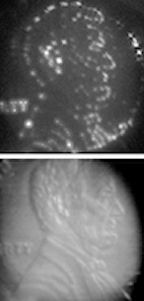A newly unveiled tactile sensor rivals the sensitivity of human skin. When pressed against a penny, for instance, the film can distinguish the wrinkles in Abraham Lincoln’s clothing.

The transparent film—broader than a fingertip but less than one ten-thousandth as thick as typical human skin—may ultimately boost the tactile sensitivity of robots, says chemical engineer Ravi F. Saraf of the University of Nebraska in Lincoln. It may also give surgeons using endoscopes a means to remotely evaluate tissue texture.
Saraf and Vivek Maheshwari, also of the Lincoln campus, describe their novel sensor in the June 9 Science.
With up to 25 volts of electricity powering it, the 100-nanometer-thick, multilayer membrane translates pressure into light and electric current. To do so, it exploits the quantum phenomenon of electron tunneling, in which electrons pass through seemingly impenetrable barriers.
In an uncompressed sensor, electrons responding to the voltage would tend to flow between layers of gold nanocrystals and layers of cadmium sulfide nanocrystals, but sheets of insulating polymers bar the way. When the sensor touches something, pressure at spots along the film forces the nanoparticle layers closer together, raising the tunneling odds and allowing electricity to flow at those spots. Because an electric current makes cadmium sulfide glow, the sensor yields an image of the topography it contacts.
The sensor can distinguish side-to-side features only 40 micrometers across. Other touch sensors that span comparable postage–stamp–size areas discern features no finer than a couple of millimeters across, Saraf notes.





